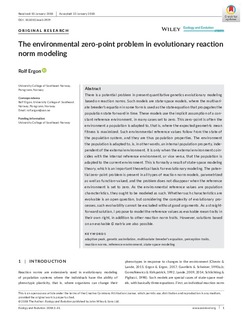| dc.description.abstract | There is a potential problem in present quantitative genetics evolutionary modeling based on reaction norms. Such models are state‐space models, where the multivariate breeder's equation in some form is used as the state equation that propagates the population state forward in time. These models use the implicit assumption of a constant reference environment, in many cases set to zero. This zero‐point is often the environment a population is adapted to, that is, where the expected geometric mean fitness is maximized. Such environmental reference values follow from the state of the population system, and they are thus population properties. The environment the population is adapted to, is, in other words, an internal population property, independent of the external environment. It is only when the external environment coincides with the internal reference environment, or vice versa, that the population is adapted to the current environment. This is formally a result of state‐space modeling theory, which is an important theoretical basis for evolutionary modeling. The potential zero‐point problem is present in all types of reaction norm models, parametrized as well as function‐valued, and the problem does not disappear when the reference environment is set to zero. As the environmental reference values are population characteristics, they ought to be modeled as such. Whether such characteristics are evolvable is an open question, but considering the complexity of evolutionary processes, such evolvability cannot be excluded without good arguments. As a straightforward solution, I propose to model the reference values as evolvable mean traits in their own right, in addition to other reaction norm traits. However, solutions based on an evolvable G matrix are also possible. | nb_NO |

